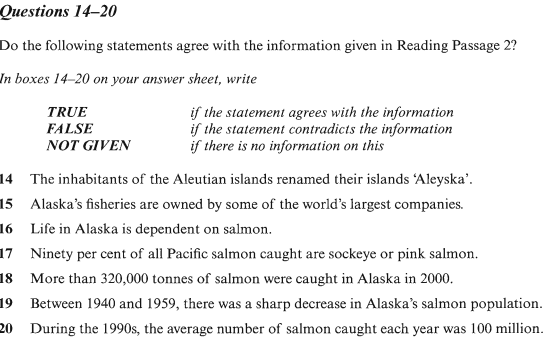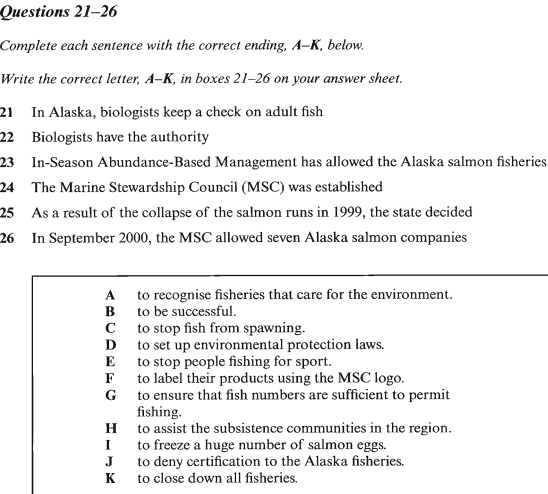剑桥雅思7阅读:Test4雅思阅读PASSAGE 2真题+答案+解析
发布时间:2021-01-04 关键词:剑桥雅思7阅读:Test4雅思阅读PASSAGE 2真题+答案+解析READING PASSAGE 2
You should spend aboul 20 minutes on Questions 14- 26, which are based on Reading Passage 2below. .
Endless Harvest
More than two hundred years ago, Russian explorers and furhunters landed on the Aleutian Islands, a voicanic archipelagoin the North Pacific, and learned of a land mass that lay
farther to the north. The islands' native inhabitants called thisland mass Aleyska, the 'Great Land'; today, we know it as
Alaska.
The forty- ninth state to join the United States of America (in1959), Alaska is fully one- fifth the size of the mainland 48states combined. It shares, with Canada, the second longestriver system in North America and has over half the coastline of the United States. The rivers feed into the Bering Sea and Gulf of Alaska - cold, nutrient richwaters which support tens of millions of seabirds, and over 400 species of fish, shellfish,
crustaceans, and molluscs. Taking advantage of this rich bounty, Alaska's commercial fisherieshave developed into some of the largest in the world.
According to the Alaska Department of Fish and Game (ADF&G), Alaska's commercial fisherieslanded hundreds of thousands of tonnes of shllfish and herring, and well over a million tonnesof groundfish (cod, sole, perch and pollock) in 2000. The true cultural heart and soul of Alaska'sfisheries, however, is salmon. "Salmon,' notes writer Susan Ewing in The Great Alaska NatureFactbook, 'pump through Alaska like blood through a heart, bringing rhythmic, circulating
nourishment to land, animals and people.' The 'predictable abundance of salmon allowed somenative cultures to fourish,' and dying spawners* feed bears, eagles, other animals, and ultimatelythe soil itself.' All five species of Pacific salmon - chinook, or king; chum, or dog; coho, or silver;sockeye, or red; and pink, or humpback - spawn** in Alaskan waters, and 90% of all Pacific
salmon commercially caught in North America are produced there. Indeed, if Alaska was anindependent nation, it would be the largest producer of wild salmon in the world. During 2000,commercial catches of Pacific salmon in Alaska excceded 320,000 tonnes, with an ex- -vessel valueof over $US260 million.
Catches have not always been so healthy. Between 1940 and 1959, overfishing led to crashes insalmon populations so severe that in 1953 Alaska was declared a federal disaster area. With theonset of statehood, however, the State of Alaska took over management of its own fisheries,guided by a state constitution which mandates that Alaska's natural resources be managed on a
sustainable basis. At that time, statewide harvests totalled around 25 million salmon. Over the nextfew decades average catches steadily increased as a result of this policy of sustainable management, until, during the 1990s, annual harvests were well in excess of 100 million, and onseveral occasions over 200 million fish
The primary reason for such increascs is what is known as In-Season Abundance-Based
Management'. There are biologists throughout the state constantly monitoring adult fish as theyshow up to spawn. The biologists sit in streamside counting towers, study sonar, watch fromaeroplanes, and talk to fishermen. The salmon scason in Alaska is not pre -sct. The fishermen
know the approximate time of year when they will be allowed to fish, but on any given day, one ormore feld biologists in a particular area can put a halt to fishing. Even sport fishing can be
brought to a halt. It is this management mechanism that has allowed Alaska salmon stocks - and,accordingly, Alaska salmon fisheries - to prosper, even as salmon populations in the rest of theUnited States are increasingly considered threatened or even endangered.
In 1999, the Marine Stewardship Council (MSC)** commissioned a review of the Alaska salmonfishery. The Council, which was founded in 1996, certifies fisheries that meet high environmentalstandards, enabling them to use a label that recognises their environmental responsibility, The
MSC has established a set of criteria by which commercial fisheries can be judged. Recognising thepotential benefits of being identifed as environmentally responsible, fisheries approach the
Council requesting to undergo the certification process. The MSC then appoints a certificationcommittee, composed of a panel of fisheries experts, which gathers information and opinionsfrom fishermen, biologists, government officials, industry representatives, non-governmentalorganisations and others.
Some observers thought the Alaska salmon fisheries would not have any chance of certificationwhen, in the months leading up to MSC's fnal decision, salmon runs throughout western Alaskacompletely collapsed. In the Yukon and Kuskokwim rivers, chinook and chum runs were probablythe poorest since statehood; subsistence communities throughout the region, who normally havepriority over commercial fishing, were devastated.
The crisis was completely unexpected, but researchers believe it had nothing to do with impacts offisheries. Rather, they contend, it was almost certainly the result of climatic shifts, prompted in
part by cumulative effects of the el niño/la niña phenomenon on Pacific Ocean temperatures,culminating in a harsh winter in which huge numbers of salmon eggs were frozen. It could havemeant the end as far as the certification process was concerned. However, the state reacted quickly,closing down all fisheries, even those necessary for subsistence purposes.
In September 2000, M$C announced that the Alaska salmon fisheries qualified for certification.Seven companies producing Alaska salmon were immediately granted permission to display theMSC logo on their products. Certification is for an initial period of five years, with an annualreview to ensure that the fishery is continuing to mcet the required standards.






